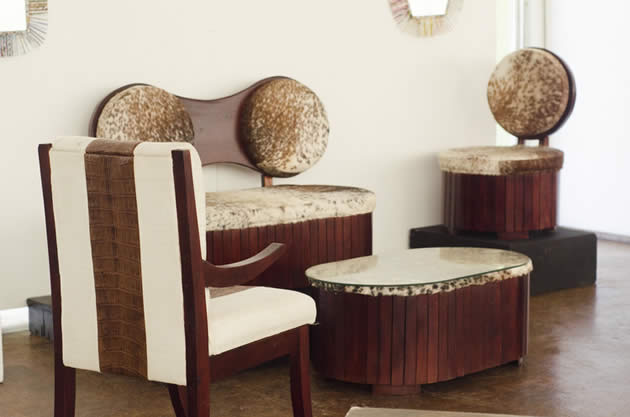Zimbabwe’s heritage in design

AT THE GALLERY
In the previous article on Zimbabwe In Design, it was stressed that design affects purchasing choices and can even override quality in the process of determining the purchase of the product on offer. This is often a conscious decision made by the consumer however there are subconscious aspects of design that may influence the individual’s design choice.
The most common aspect of Zimbabwean Design is the Pole and Dhaka hut which is both an object of utility whereas it was usually festooned with patterns and motifs. In this manner, the hut differed from the western concept of a home that is shared by a nuclear family and subdivided into a kitchen, dining room, lounge and bedrooms whilst located in an allotted yard when compared to a homestead containing several huts that bear different purposes; the dormitory houses such as sikiro for the parents or head of the household, nhanga being the residence of female offspring and gota housing the male offspring.
The traditional western yard of four corners is abstract in the Zimbabwean context where chivanze is usually a circular clearing surrounds for all the houses. At the centre of most homesteads is the kitchen, which is infused with several designs.
Opposite to the doorway there is a clay pot shelf known as chikuva which is associated copiously with inheritance and national spiritual beliefs. The aspect of having a specific layout within Zimbabwean homes, predominantly rural, leads to the question of whether a Zimbabwean style of Contemporary Architecture can be innovated to its Modern precedent.
The exterior and interior facets of Zimbabwean design in homes are underplayed and it is to this end that Zimbabwe In Design aims to ensure that the public gets an understanding of the dynamics that exist around them. The relevance of construction in a particular manner and the arrangement of objects in the built environment in Zimbabwean context are of high esteem be it in constructing houses, laying out communities or planning urban settlements.
Closer to home there is a correlation between the exterior and interior elements. Interior design tends to keep up the western trend whereas there is much on offer in regards to Zimbabwean design. Tendai Mudzingwa of Forgrace Arts & Crafts practices as an African Décor Designer in Harare and she accentuated the point that the consumption of local décor concepts is deplorable.
“We work with objects that are natural to our environment in regards to furniture and ornaments. Our products utilise materials we find in the natural environment immediately around us.” Mudzingwa said. “We draw all our inspiration from traditional architecture and design so as much as we produce a quality product that gets to fit in a setup that ranges from an African décor to a Western décor.” She added.
Upon being asked whether Zimbabweans can fully re-adopt classical indigenous style and design she responded; “We are faced with the challenge that most people have shunned anything associated with African design such as mutsago, hari and anything of a decorative nature as anathema. In such an environment the means of design that have been present until now run the risk of being lost, leaving us as a people without a design culture.”
She went on “It would be of great importance if local corporations and institutions were to route for local design. Hotels are often decorated in a western style as opposed to being the port of call to tourists and introducing them to a local design philosophy,” Mudzingwa said.
“There must be some sort of education that introduces the importance of traditional design. In the long run, not only businesses must be indigenised but the public’s taste and cultural orientations must follow suit in a mindset shift to local design,” she said. “When one develops a liking or finds appeal in African crafts they are branded ‘gwaash’ or receive any other kind of labelling, however when the same product is interpreted from a western standpoint it is highly chic,” she concluded.
Another common feature in the Zimbabwean homestead is the stool and this has been re-invented in the contemporary to reflect elements that are synonymous with Zimbabwean identity such as the clan totem. Tengenenge Sculptural Community based artist Wilfred Tembo is testament to this infusion of Zimbabwean identity and design and amongst his inventory of works is His Excellency, President Mugabe’s 90th birthday commemorative chair and the Speaker of the House of Assembly’s chair at Parliament Building.
Zimbabwe In Design caught up with Wilfred Tembo who is currently committed to executing two chairs for the Parliamentary Houses. On being asked of his clientele base he responded that the majority of buyers of his chairs mostly originated from Europe, mainly German and Dutch clients. He expanded that he also deals with many Swiss buyers and that there are also Americans commissioning his work nowadays. Clients originate from the Democratic Republic of Congo to buy his work, having a greater appeal there than on the local market which has veritably fewer but considerably affluent end users.
“My work carries a uniquely Zimbabwean design and this is easily identified due to the fact that it is in the Shona sculptural style,” Tembo said. “The stone itself is only accessible locally and thus makes the work peerless on the global stage” he continued.
Tembo’s value is added to work with wood, leather and stone with the use of animal hide being an accessory for the more estimable buyers. The work is characterised by a stone base that has anamorphic features. “My chairs are based on totemic connection. Anyone can come to me and request a chair of any size and state their totem and I will work according to that theme.” He said, “The aspect of the totem is African and to design these chairs in the Shona sculpture style carries a mark of Zimbabwean identity.”
“When I work I enter a spiritual conversation with the work and usually I end up with numerous bases for the chair that represent a certain animal and these chairs are often bought by customers regardless of their incomplete status,” Tembo said. “In that incompleteness there still is a high quality of clan or national identity which makes the design of the artwork a truly Zimbabwean construct.”
Upon being asked what his aspirations for design in Zimbabwe were, Tembo stated that he wants to design a chair for each and every chieftaincy. His vision is to create an object that has a meaning and a potency to withstand time therein becoming a family or the national heritage whilst it is within itself functional.
Both Mudzingwa and Tembo’s designs will be on show at Zimbabwe In Design which will be opening at the National Gallery of Zimbabwe on the 30th of April 2014.
The meaning of design and its unlimited presence around Zimbabwe will be exposed and the links to age old customs in decoration and construction will be revealed through the work that will be on display and the other work that will be on offer. This does not mean that modern design will not feature. On the contrary many examples of modern, urban and chic designs will form an important aspect of the show.








Comments